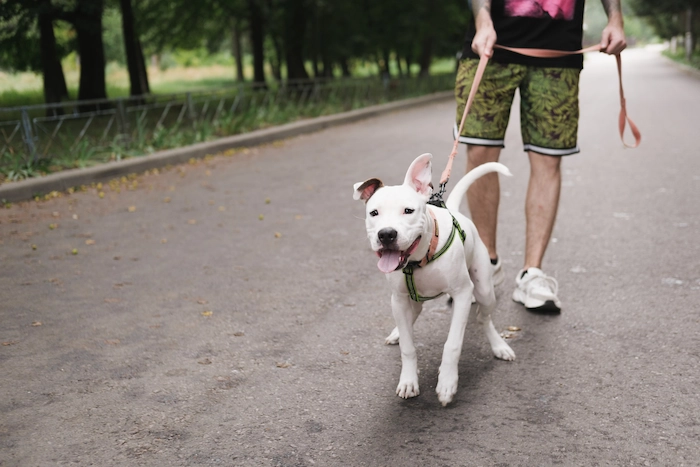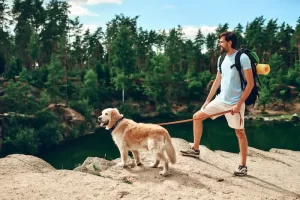
Going for walks is a fun activity for both you and your dog. But loose leash walking can be challenging for every puppy.
When your dog starts pulling on the leash and ignoring your directions, it’s hard to enjoy your stroll around the neighborhood. That’s what makes leash training so important — a well-trained puppy helps create a healthy dynamic between owner and pet.
Puppy Behavior and Readiness for Leash Training
So, how do you know when your puppy is ready to start leash training? Typically, puppies won’t leave their mothers until they’re 8-12 weeks old. So most dogs can start training as soon as they get to their forever home.
At this age, your puppy can recognize praise for good behavior, but it won’t have a fully developed sense of self-control. For this reason, short training sessions are ideal. Positive reinforcement and patience are crucial to making things stick. Still, it’s a good time to introduce it to its leash and collar and familiarize it with following you around the house.
Puppies are impressionable even during these early weeks of life, making it an excellent time to incorporate other obedience training sessions. It’s also a good idea to start socializing your puppy during this formative stage. Getting used to other dogs early can make the training process more straightforward.
Choosing the Right Leash and Collar: Halo Collar
Before training puppies to walk on a leash, it’s crucial to choose the right equipment. For modern dog owners, this means wading through a sea of choices.
When selecting a collar, the fit is an essential factor. Too tight and your dog will be uncomfortable — but too loose puts it at risk of slipping out and running off. Generally, if you can fit two fingers underneath the collar, your dog will be comfortable.
From there, you can choose a standard or a retractable leash. Retractable versions are good for those who like to give their furry friend room to roam, but standard leashes are usually best for dogs who aren’t yet leash trained.
In addition to leash training, if you have a dog that is 6 months old already, many pet parents use tools like the Halo Collar for its holistic design and built-in training system. The Halo Collar complements leash training by providing an effective way to create positive associations with good behavior using haptic feedback. This method proves to be more accurate than treat-based rewards and taps into your dog’s natural learning instinct.
It’s important to note that the Halo Collar is not a substitute for leash training. Rather, it offers an alternative approach that can enhance your dog’s overall training experience. Moreover, the Halo Collar is co-founded by renowned dog-training expert Cesar Millan and features an adjustable strap for the perfect fit.
Introducing the Leash and Collar to the Puppy
Now, you can start introducing the leash and collar to your pup. It’s best to do this indoors at first, where distractions are minimal. Simply let your dog sniff each one while you offer treats and praise. This will help your dog view the gear positively as you move forward.
Once it’s sniffed out the collar, put it on your dog and reward it with a treat before removing it. If your dog still seems happy after a few repetitions, begin keeping the collar on for longer periods before taking it off. Offering toys and more treats can help it get comfortable wearing the collar while engaged in other things.
After normalizing the collar, it’s time to incorporate the leash. Practice moving around indoors at first in a space familiar to your puppy. Reward it with plenty of treats just for wearing the leash, and encourage it to stay near you.
If your puppy seems stressed or frightened by the leash and collar, take a break before trying again. Moving too quickly could cause your dog to develop negative associations — the opposite of what you want. In the same vein, avoid leaving your puppy unsupervised with its gear until it’s completely comfortable.

Basic Leash Training Techniques
When your dog is used to the leash and collar, you can practice walking inside. At this point, walking alongside you for even a few steps is good progress.
As your puppy grows more comfortable with the leash, start practicing in environments with more distractions to build and strengthen its focus. Stick to controlled spaces like the backyard before moving to challenging areas like the dog park. Stay attuned to your dog’s comfort level — increasing distractions too early could be overwhelming.
Combining loose leash training with obedience can also encourage good behavior on walks. Telling your dog to sit, stand, or heel while leashed reinforces your authority and can prevent pulling and lunging. The Halo Collar is particularly useful for this purpose, as its haptic capabilities send your dog a positive signal for following commands.
Before adding commands to your training sessions, know what you want to accomplish in advance. According to Cesar Millan, setting an intention helps you project confidence and authority. Your puppy will recognize the dominant behavior, making it more responsive to your commands.
Above all, stay calm and collected as your puppy learns. Anticipating challenges can help you adapt and respond effectively at the moment.
Common Challenges and Solutions in Leash Training a Puppy
Some behaviors can make it hard to leash train a puppy. Luckily, a few simple solutions can prevent pulling and biting in even the most unruly puppy.
If your dog pulls on its leash, the first thing to do is stop moving completely until the leash goes slack. Once your dog yields to you, keep moving. It’s important not to reward this behavior accidentally, so avoid giving treats even after the pulling stops.
A similar solution works for leash biting. First, stop moving. Using a treat to get your dog’s attention, give it a new command, such as sit or lie down. Then, reward it.
When troubleshooting your leash training, patience is key. Learning a new skill can be frustrating for a dog, and positive encouragement will keep its spirits up.
The Halo Collar: Puppy Training Made Easy
The Halo Collar goes beyond teaching your puppy to walk and can enhance training sessions with advanced instruction. It proves particularly useful for distance commands, allowing you to give your dog direction even when it’s not within arm’s reach. While learning to walk correctly remains an essential skill, it’s important to note that the Halo Collar does not directly influence walking behavior. Instead, it serves as a valuable tool to support your training efforts.
When your dog wears the Halo Collar, the haptic feedback it provides helps reinforce and retain the necessary skills. This ensures that your pup stays safe and happy wherever your adventures take you.






